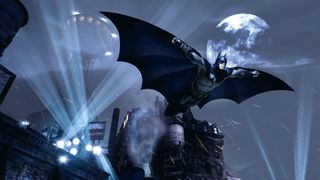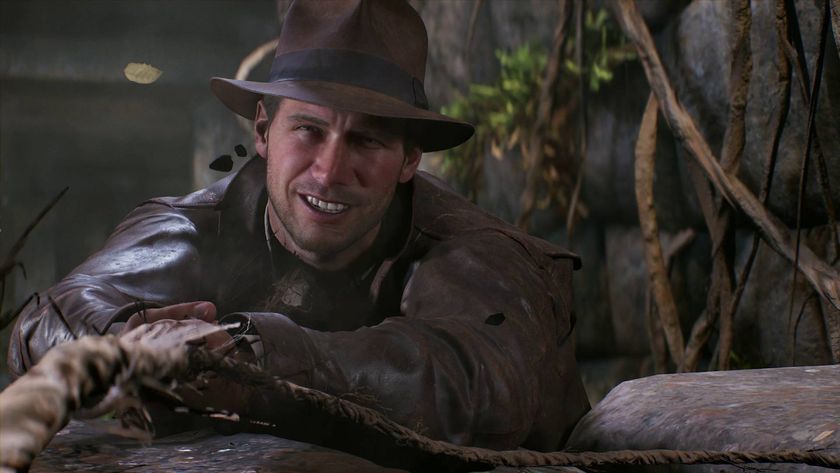Batman's cape - How a cloak drew players into the cowl of Gothams protector
Making a great licensed superhero game is tough. Not only must developers overcome all the regular hurdles of production, they also face the challenge of making players feel like the hero on the front of the box – tricky when many comic book powers are potentially game breaking. The current apotheoses of this dark art are 2009’s Batman: Arkham Asylum, 2011 follow-up Arkham City and prequel Origins (and the upcoming Arkham Knight). But of all that Rocksteady has painstakingly crafted to capture the experience of being the Dark Knight, the cape stands apart.

There’s an iconic quality to those yards of billowing mantle, of course, with a silhouette that’s been ingrained in pop culture for decades. And its assured fabric physics – the cape billows in the wind, its edges flick when Bats runs and it swings with a persuasive sense of weight – communicate Rocksteady’s labour of love in bringing this character to life. Yet the real genius is in how the cape informs your interaction with the gameworld.
Chiefly, this comes down to the ability to glide through the night on those unmistakable wings – an unusual method of locomotion in games (why coast when you could soar?), but one that proves satisfyingly empowering in both the confined halls of Arkham Asylum and the wide-open districts of Arkham City. It suits Wayne’s dramatis personae perfectly, allowing him to swoop into action where Solid Snake might skulk, to bear down on his foes where the gun-toting masses of generic action heroes would prefer to keep them at range.
What’s more, the distinction between gliding and flying proves immense in Rocksteady’s hands. All you’re ever doing is putting off the inevitable moment when your boots meet terra firma once again, and yet that very limitation, wedded to a finely honed control scheme, enhances the sense of character. You’re no all-powerful god who’s able to defy gravity at a whim, but you do transcend the masses in a very literal sense, going to places others can’t through a mix of technology and your own skill.

And your ability opens Rocksteady’s two Batman games up, enabling you to exploit the dizzying spires, watch towers and stoic gargoyles scattered about the environs. The Bat Claw may be what gets you up there, but what good would such high vantage points be if coming down meant a lengthy climb or shattered femur? Assassin’s Creed’s Altaïr and Ezio may have required the contrivance of conveniently placed hay carts to break their falls, but Batman isn’t the kind of hero who needs a crash mat. Instead, the cape releases you to explore free of consequence, and drop into the heart of the action whenever the view from a lofty peak captures your interest.
Bats’ cape is more than a means of simply getting from A to B, though; its hallmark power is irreplaceable in a series that regularly asks you to seek the height advantage. While this applies throughout the games, it’s perhaps best exemplified by their recurring silent predator rooms; Batman may be devastating in a fist fight, but he isn’t bulletproof and so areas full of armed thugs provide reason to be cautious. The levels are usually set up so that you can get to a high point to survey the scene, pick your marks and choose the right time to strike. It’s an approach that helps players feel clever and considered – traits that once again communicate the feel of being Batman without having to be the world’s greatest detective. Where the cape fits in is by allowing you to gain this tactical advantage and then apply it in an instant – swooping down from the rafters to deliver a punishing glide kick (at which point the game takes over the steering, providing cinematic precision over pure agency), or positioning yourself in exactly the right spot to set up your next takedown. It’s a brand of brutally efficient play few other protagonists can deliver.

It’s only when players hit the dilapidated streets of Arkham City that the cape’s full potential unfurls. Bolstered by an easy-to-learn, harder-to-master system of dives and swoops that can keep you airborne for longer, and, working in tandem with the new Bat Claw boost, it unleashes a different kind of Caped Crusader on Gotham’s underworld. It gives us control of the guardian who hovers aloft over a crime-riddled city, picking his battles as opposed to just the next target, and allowing for hit-and-run tactics on a grand scale.
Sign up to the 12DOVE Newsletter
Weekly digests, tales from the communities you love, and more
Such mastery over the skies serves to highlight that Arkham City is a world in three parts: the mean streets, awash with crims and icy waters; stately buildings corrupted to serve as galleries for the game’s many rogues; and the perilous roof-scape that connects them. The cape means the latter is yours to conquer – each building is just a short glide away from the last, but almost all present either a Riddler puzzle to solve, foes to best or new secret to absorb. While other game heroes are locked to linear paths on street level, Batman has the run of the place, his progress gated only by his collection of gadgets. Arkham City cleverly asks more of your aeronautical skills, stretching them with a series of fiendish augmented reality challenges that play out across the skies and beneath the underpasses of its ramshackle playground.

They may recall Pilotwings in style, but never has guiding a man through hoops made us feel as utterly heroic. And that’s the true secret of the cape: its abilities can transform even moments that might be mundane elsewhere into a darkly thrilling rush, doing justice to its storied legacy.
Read more from Edge here. Or take advantage of our subscription offers for print and digital editions.
Edge magazine was launched in 1993 with a mission to dig deep into the inner workings of the international videogame industry, quickly building a reputation for next-level analysis, features, interviews and reviews that holds fast nearly 30 years on.

















